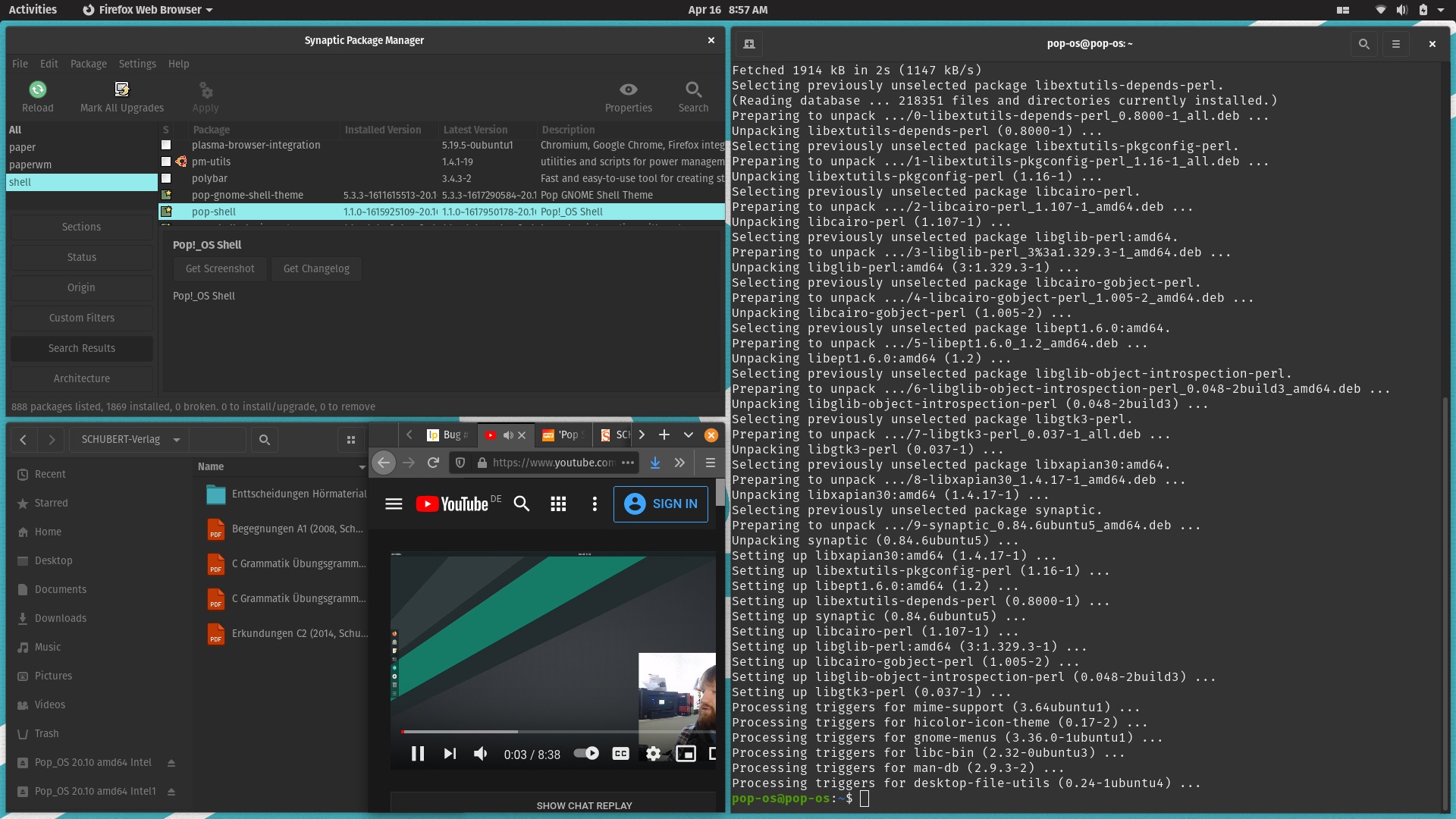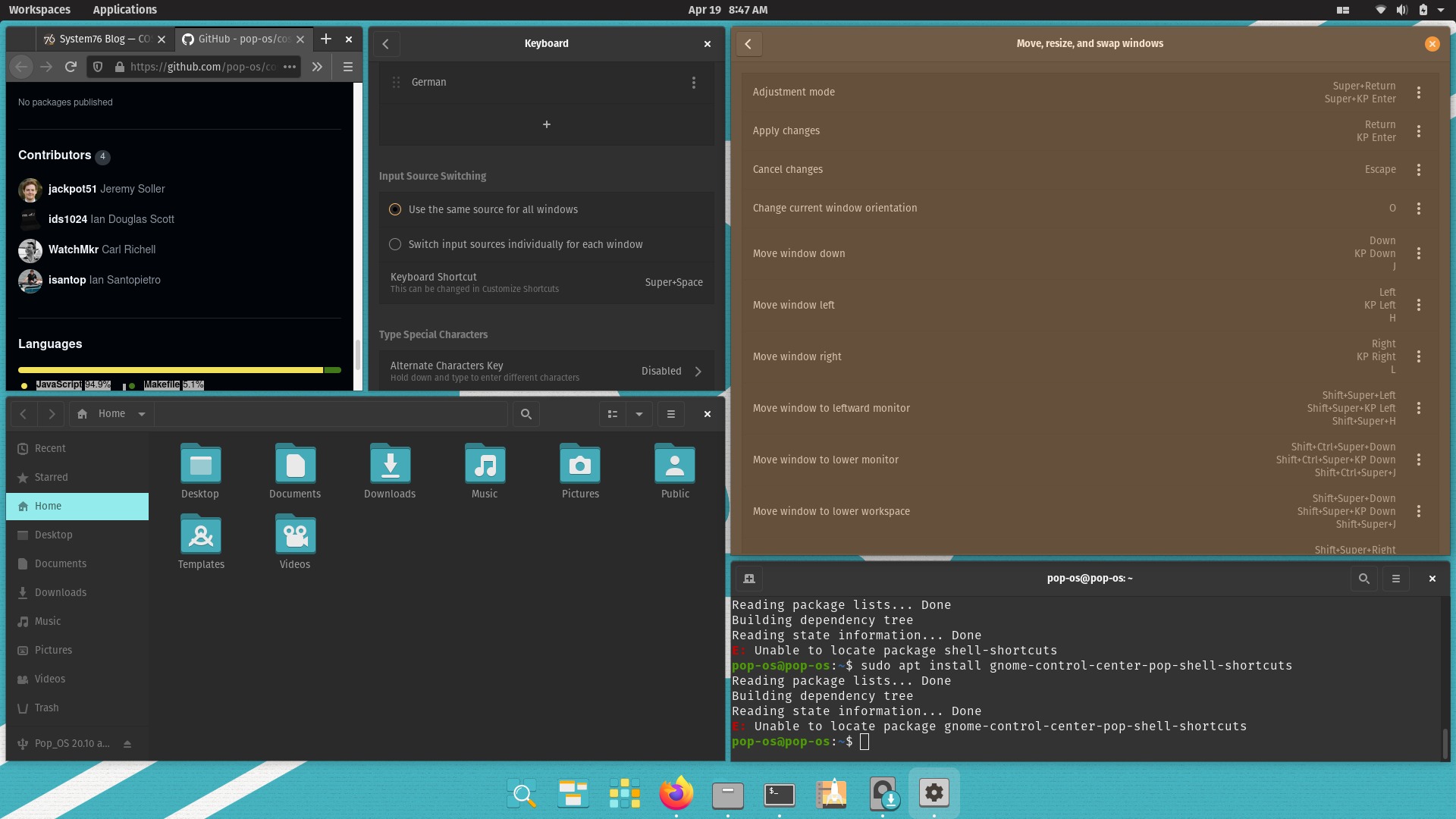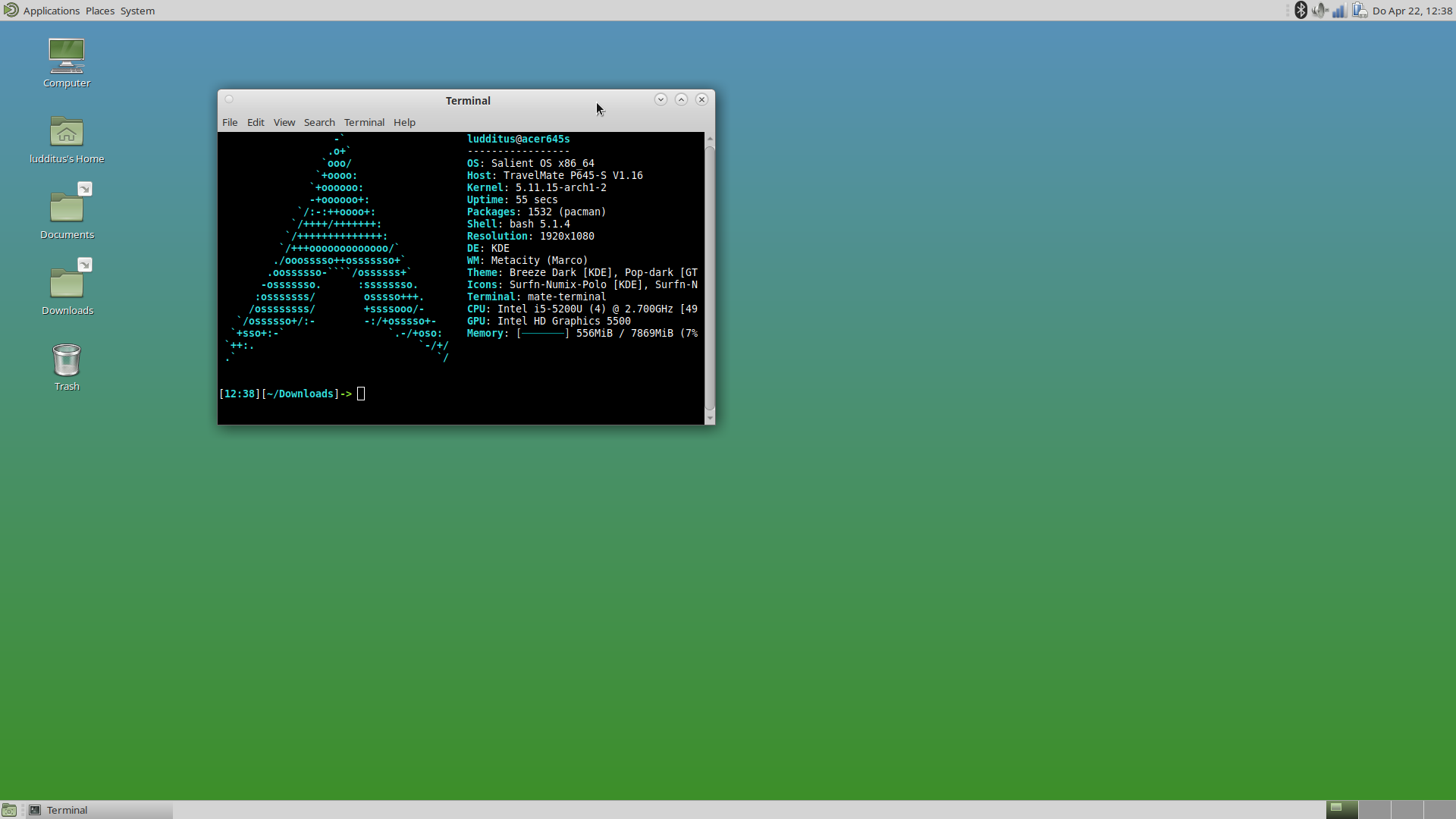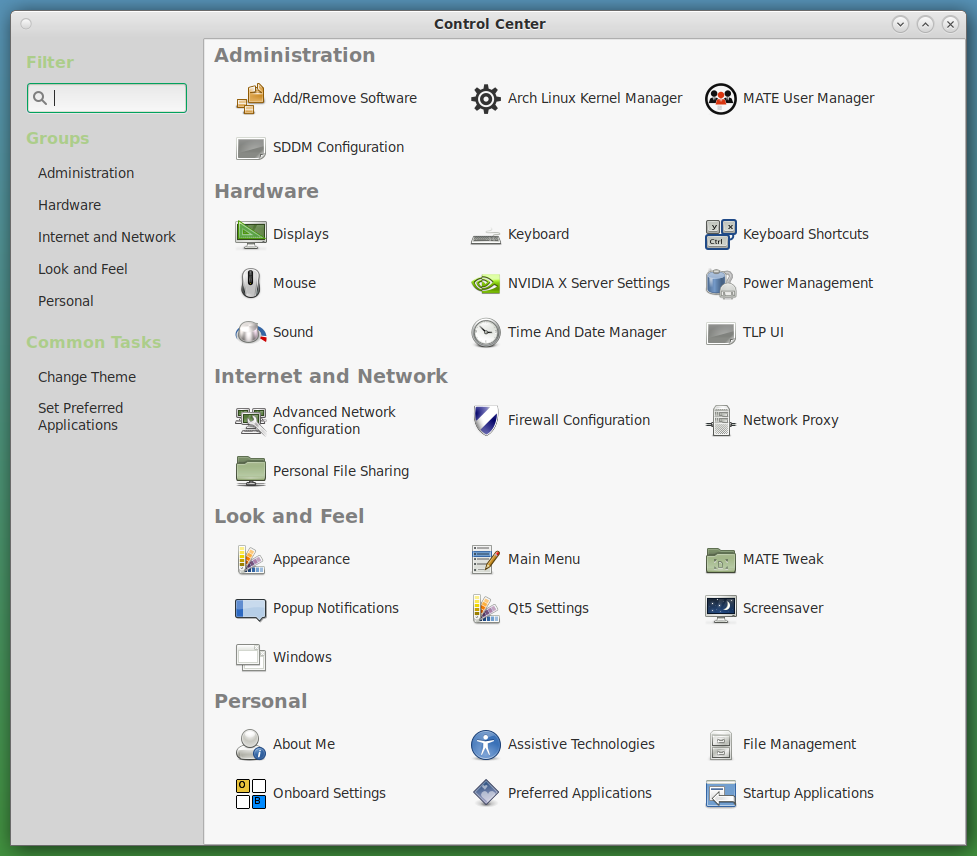I tried to understand GNOME, and I failed at COSMIC tiling too; could I have some MATE again?
Against any logic, and mostly out of esthetic and usability curiosity, I wanted to try GNOME. Not version 40 yet, but 3·38 in Pop!_OS, with the tiling manager Pop Shell and the upcoming COSMIC thing to be released with Pop_OS 21.04 in June.
1.
I’m not sure why I did it. I knew I didn’t find GNOME usable in the past, and I knew there are usability issues that won’t change, and that make it a no-go for me. My top 3 anti-usability features:
- GNOME Shell, which makes it look like an Android tablet, and which is retarded at best. I know there’s a thing called GNOME Classic, but why GNOME 3.x/40 then, if the idea was to have something that looks like GNOME 2.32 or MATE?
- Minimize and maximize windows buttons not showing by default, GNOME Tweaks not part of GNOME, and, no matter what, Firefox cannot be minimized at all! Not with the mouse. I don’t have to try GNOME 40 to check whether that’s still true–Dedoimedo did it for me, and GNOME 40 is still The anti-desktop desktop.
- No Compact mode in the file manager. I’m surprised that few people are missing it! Nautilus had it (so Caja still has it). Thunar has it. Nemo has it. Dolphin has it. PCManFM has it. GNOME 1.0 had it back in 1999! (It was called “Brief”…)

I know people who only use the detailed mode… in Windows 10. I don’t understand them, and I never will. With the detailed view, I can’t even right-click “in the middle of nowhere” to create a new document, or to paste from the contextual menu instead of CTRL+V, etc., because it will select an item (file or folder). The file manager sucks enormously in GNOME 3.x/40.
Oh, wait! Even in the icon mode, I can’t right-click “in the middle of nowhere” to create a new document, because this option doesn’t exist in GNOME 3.x/40! Apparently, it was removed in 2013. It might have been patched downstream by adding an empty file template, because people noticed its disappearance one more time in 2015, then in 2016 (GNOME 3.20), and also in 2018.
One must be a complete idiot to choose GNOME 3.x/40 over KDE, XFCE, Cinnamon, MATE.
2.
And yet, some loved it so much, that they even made KDE look partially like GNOME! It’s the case of the guys from TeLOS, “a new, humble Linux Debian distribution”:


So I had to try it one more time, to see how usable it might prove to be. GNOME, I mean.
3.
One more thing I tried to understand: those people who are fans of tiling window managers. You know, i3, bspwm, herbstluftwm, Ion, awesome, dwm, wmii and whatnot. As something as “primitive” as a tiling window manager would seem so 1990, I thought of trying GNOME 3.38 in Pop!_OS 20.10, because its Pop Shell acts as a tiling engine! Sure thing, potentially better GNOME tiles extensions do exist, such as Material Shell, recently reviewed by Dedoimedo (“Material Shell builds on a bad design and extends it, but cannot resolve the underlying problem. … I liked the novelty, but I found the workflow weird and not as optimal as it can be.”) but I thought I should go the easiest way. Pop Shell too is a click away.
Watching DistroTube’s A Tiling Desktop Environment? Introducing The Pop Shell! didn’t help me understand why should I try it, and neither did Running the System76 Pop Shell (on Ubuntu 20.04), but I didn’t want to try it under Arch (as Ermanno Ferrari did), so I opted for the safer side.
A last common-sense deterrent against Pop!_OS though, from Christopher Barnatt, futurist, videographer and Associate Professor of Strategy & Future Studies in Nottingham University Business School, whose video review Pop!_OS: Creative Linux Distro includes some specific criticism at 11:46 Missing Stuff:
It’s not missing, it’s by design.
But then, this guy, despite being a futurist and a fan of 3D Printing, of Raspberry Pi and of everything new, it’s rather conservative. Take a look at his desk: a CRT on the left side, a 4:3 CRT video monitor at the right, and the TFT is definitely having an aspect ratio of 5:4 (1280×1024 or 1600×1280)!

4.
There’s no public beta of Pop!_OS 21.04, and the final version will be released in June, so I had to try Pop!_OS 20.10.
The first thing I noticed, the lack of theming for KDE/Qt apps. Back in the times of KDE3 and of GNOME2, I remember how most distros were taking care of having GTK+/GNOME2 apps look decently well under KDE3, and Qt/KDE3 apps look less than bad under GNOME2. For instance, there were things like QGtkStyle and gtk-qt-engine. Even today, there still are efforts to have a Uniform look for Qt and GTK applications… just not in Pop!_OS!

One more comparison to show the arrogance of System76, who thought people should only use GNOME/GTK apps in Pop!_OS:


Moving on, I first tried the tiling manager without the new COSMOS engine.
2 windows are fine, but what’s the benefit of having such a huge calculator? I don’t grasp the utility of automatic tiling!

3 windows… OK… -ish.

In the process, I noticed “the Ubuntu heritage”: the file .sudo_as_admin_successful, added by Ubuntu in 2009 and vigorously defended (people even filed bug reports when it failed to be created!). OMG, Ubuntu.
3 windows displayed as 2… with a terminal and Synaptic in a unique tabbed window! HELP!

The keyboard shortcuts from the Git page don’t include anything about suddenly tabbed windows, so I’m out of luck. Oh, something happened, and I don’t know what I did for that to happen, but Firefox is now so tiny!

I guess I entered the edit mode, because the tiling is imperfect: Firefox was partially under the file manager, and now it’s above it!

Non-tiled was much fucking better.

5.
It’s time I went COSMIC. I only needed to change the repos from groovy to hirsute, and to run:
sudo apt update
sudo apt install pop-cosmic libpop-desktop-widget gnome-shell-extension-ubuntu-dock gnome-shell-extension-multi-monitorsYes, I know, this might break everything, but it was just in the live session, and just for testing COSMIC, which doesn’t require GNOME 40, but 3.38+ (and Pop Shell, and the Pop theme), so I only installed what was required and nothing more. No updates whatsoever.
I then needed to activate everything that wasn’t:

Yes, it does have a dock! Here’s what the first 3 icons are there for:



As for the automatic tiling, it started smoothly, but eventually I got lost:



Why is the dock preventing other windows from using the entire screen? Is it a dock, or a panel?!
Let’s try the edit mode aka window adjustment mode (Super+ENTER):

It works like shit IMO, and the results are a bit unpredictable:


Err… windows got under the dock, yet the dock isn’t hidden. But only the file manager got under the dock, not the terminal! (Note how in the last two screens I changed the view in the file manager; despite it being active, the dock couldn’t care less.)
6.
I decided to throw in the towel. Tiling windows is dumb. Pop!_OS is dumb. GNOME is dumb. COSMIC is probably useless and hopeless (and still in beta, I guess).
Most of all, GNOME is dumb. Files (a dumb name for Nautilus, something that I thought was trademarked by Microsoft) is something beyond usability, not having a compact list mode (in other words: 3 view modes!). Minimizing windows (or Firerfox!) is dumb. Theming KDE or Qt apps isn’t taken care of.
Also, for those who remember my problem with undetected headphones jack (and most likely undetectable in newer kernels, for reasons I won’t bother to repeat), GNOME has this extra issue of not allowing me to select the audio jack, typically “Headphones (not connected)” in other desktop environments:

It only sees the built-in speakers, it only has them in the list. How dumb is that?
The last bug I discovered in GNOME, at least in this edition of Pop!_OS (likely inherited from Ubuntu), regards the German set of keyboard layouts. KDE properly reads and displays everything that xkeyboard-config has, i.e. for Germany, beyond all flavors of German layouts from Germany, Austria, and Switzerland, something called “Romanian (Germany)“; basically, the German QWERTZ (with ÜÖÄß etc.), with added Romanian letters on AltGr (a bit incorrect, using the Turkish şţ instead of the correct șț, but I have identified the bug). GNOME, under Germany, after having listed more or less the same German, Austrian, and Swiss layouts of all kinds, skips the “German Romanian” only to add… “Italian (international, with dead keys)“! That’s not only useless, it’s also totally wrong, as it’s a QWERTY layout!
7.
The funny thing is that Kubuntu 21.04 might have a raison d’être, even if Ubuntu and Pop!_OS, and other things might seem dumb. Buggy as it still is, I know for a fact that version 21.04 comes with some improved hardware support. My wife’s cheap HP Pavilion Gaming Desktop TG01-1209ng (“gaming” my ass, it’s labeled “gaming” because of its almost decent Nvidia GeForce GTX 1650 with 4 GB GDDR5, but it’s not used for games) has rtl8821ce for WiFi and Bluetooth, and this chip is not supported by any of the Live ISOs I tried: ArcoLinux KDE, Salient OS, Debian testing weekly KDE with non-free firmware, siduction. So the only distro I could install on that HP over the WiFi (I don’t have that a long patch cord!) could only be something based on Ubuntu 21.04!


Of course, were System76 be a worthwhile hardware brand, and were they offering a KDE edition of their distro…
✅ UPDATE: On May 2, RebornOS has added support for Realtek RTL8821CE in the regular and the LTS ISOs.
8. Retro-Bonus
Speaking of Kubuntu 21.04, there is something that makes me think of Debian/Ubuntu every now and then. With Pacman, I really miss the DEB style. They made it inelegant with the duplication apt-get vs apt, but it’s no big deal. The RPM years are gone for me since yum isn’t anymore what it was, and DNF is pure garbage. Red Hat’s good deeds don’t count anymore, they now being IBM, greedy and stupid. Let’s not forget that they created the monster of stupidity called GNOME 3, now GNOME 40. Also, nobody else from the old-school of RPM is alive, except for openSUSE (the Mandrake/Mandriva/Mageia/OpenMandriva family is a group failure). So I feel the nostalgia for Ubuntu 4.10 and 5.04.
The release of 21.4 on April 22 is questionable IMO. After the Beta ISOs issued on April 1, there is radio silence. Release Candidate on April 15? They must have kept it under their hats. Either way, I decided to try their daily builds of April 20, for Kubuntu, Xubuntu, Ubuntu MATE.
Some of the bugs I noticed in Kubuntu with the Beta ISO were only partially patched. For instance, in the Live session I added a German keyboard layout, I removed the US English default one, but the system still acted QWERTY instead of QWERTZ (imagine I were a French, I’d have wanted AZERTY). Should I close e.g. Konsole and reopen it, the keyboard would be German, but then I opened a GTK app, and the keyboard “seen” was US English, despite it not being there!
Same for Xubuntu, except that here I never tried anything Qt, but all the GTK apps were still seeing the nonexistent US English layout:

Also in Xubuntu 21.04 “RC” (not labeled as such, but hey, it was from April 20!), the theming across CSD and non-CSD windows was inconsistent. The “Appearance” window is not CSD (“Close” is still at the bottom), but its Settings Manager parent is, so Greybird-dark is applied as intended; Thunar, Mousepad, and Xfce Terminal were however still having glassy title bars!

But what I really wanted to try was Ubuntu MATE, which to me is “the real MATE distro”–Mint being primarily Cinnamon. Between 2004 and 2011, I was a huge fan of GNOME 2, that’s why.
Surprisingly, Ubuntu MATE didn’t have any keyboard or internationalization bug I could find in the live session, and no other visible bug either! Also, as a punch in the face of System76’s arrogance and despise of Qt/KDE apps, under MATE Qt apps were themed just as their GTK counterparts, at least when Yaru dark was applied:

For all those aged 40+, MATE is trying to be helpful with EIGHT predefined layouts, of which the most meaningful ones are Familiar, Redmond and Traditional (whoever prefers Cupertino should probably use something else, not MATE; if what they’re looking for are a dock and menus that move in the top panel, Apple has everything they want!):



Loads of nostalgia. Maybe I should dual-boot Salient OS (Arch) with Ubuntu MATE 21.04, but I didn’t take the risk of installing anything Ubuntu for years now!
There is an inconvenient design with Ubuntu MATE though: why on Earth have they installed the Yaru themes and their Welcome app from the Snap Store? This is crazy!

Should I give it a longer try, I wanted to avoid anything Snap, Flatpak, AppImage, and to add the appropriate PPAs or repositories (e.g. for Sublime Text). Sigh.
Because I wanted to try something. The Ubuntu MATE thread GTK3 regressions from a GTK2 perspective shows the visual regressions introduced by GTK3 over GTK2: the new UI controls are simply dumber. Now, I understand that GNOME3 was meant for idiots, but GTK3 affected MATE, and now also XFCE. Anyway, there’s this project called gtk3-classic that I wanted to try; take a look at the “before and after” screenshots! (CSD is disabled by default.) But GTK3 Classic is already in Chaotic-AUR for the users of Arch!

9. How drinkable is MATE?
MATE is having one of the slowests evolutions of all the desktop environments (1.0: 2011-08; 1.2: 2012-04; 1.4: 2012-07; 1.6: 2013-04; 1.8: 2014-03; 1.10: 2015-06; 1.12: 2015-11; 1.14: 2016-04; 1.18: 2016-09; 1.20: 2017-03; 1.22: 2019-03; 1.24: 2020-02)… except for XFCE (4.8: 2011-01; 4.10: 2012-04; 4.12: 2015-02; 4.14: 2019-08; 4.16: 2020-12), and the changes between releases (the even numbers) are minimal. But it’s too much to complain that MATE 1.26 is still an unknown quantity. Here’s however an older comparison, from 2019, under fresh installations of Arch Linux:
- GNOME 3.32: 656 MB RAM
- MATE 1.22: 326 MB RAM
✅ Back to Ubuntu MATE, I checked the Rhythmbox and Celluloid MP3-related bugs reported by Dedoimedo for a fresh 20.10 install: they’re gone, everything works fine in the Live 21.04 ISO.
✅ In my Salient OS, I installed the package groups mate and mate-extra (I had to build mate-tweak from AUR, and it didn’t show up in the Control Center), I switched from SDDM to lightdm, I uninstalled Discover, I set Pamac to stop checking for packages, so that I could check the RAM usage after a fresh boot consistently. Here’s the initial measurements, with neofetch launched in Konsole for KDE Plasma and in MATE Terminal for MATE:
- KDE 5.21.4: 680 MB RAM
- MATE 1.24.1: 556 MB RAM


neofetch is so idiot that it believes the DE to be KDE (not “KDE Plasma” though)Ugly defaults, not to mention that Arch derivatives that bother to customize MATE give much better results and ensure a better system integration. Well, let’s theme it a bit to resemble my KDE desktop:

Themed to look decently dark, using the Brisk menu launcher, and having disabled a few unnecessary services, my desktops under Salient OS are starting like this:
- KDE 5.21.4: 661 MB RAM
- MATE 1.24.1: 597 MB RAM


neofetch still believes MATE is KDE (no version though)Making MATE look nicer had an impact, but Salient OS is much more bloated than a minimalistic Arch install anyway (possibly less bloated than installing from ArcoLinuxB MATE though; maybe EndeavourOS to be lighter). Still, MATE is 10% less memory-hungry than KDE, which is not that bad. Usability-wise, MATE’s panels are easier to customize than XFCE’s; after all these years, except for an improved Thunar and the changes to icons (including the desktop ones), XFCE is almost like it was when GNOME2 was discontinued!
I also tried gtk3-classic (formeryl gtk3-mushrooms), from Chaotic-AUR. Here’s its impact on CSD-ized GTK apps. Pamac before GTK3 Classic:

And after GTK3 Classic:

The Cancel and Apply buttons now support icons (like in GTK2), but they’re grayed out.
10. Putting myself in a new dilemma
That’s my second nature. And here’s the thing: for a maximum of comfort, MATE needs a better system integration than to install the upstream packages. Linux Mint MATE and Ubuntu MATE exist for a reason.
And Salient OS, or any Arch derivative that doesn’t care much about MATE, leads to highly suboptimal results. Here’s the pathetic MATE Control Center in Salient OS; note that “System Settings” is the KDE one, which shouldn’t be there; the “Appearance” (which should have been there!) is still accessible from the left panel, as “Change Theme”; and MATE Tweak, despite being installed from AUR, doesn’t show up here:

The MATE Control Center in RebornOS:

As a reference, the MATE Control Center in Ubuntu MATE:

I’ll leave it at that.

Added a bit of MATE/GNOME2 nostalgia… or more than a bit.
Just tried Fedora 34.
GNOME 40 is very nice, and totally unusable.
dnfdragorais slow like molasses, butyumis fine.As usual since GNOME3 & DNF, Fedora sucks.
A must test MATE derivative is iLinux OS iLinuxos.com.
I thought you were a GNOME fan.
Either way, are you kidding me? The website screams “poor taste”; the screenshots suggest a hodgepodge called in some places macédoine (figuratively).
Hahaha!
Me a GNOME fan? OMG I hate it!!!
As for iLinux OS it’s all a matter of taste! I love it! Default MATE is too little/minimal for me anymore, even though it’s still the best DE to build on…